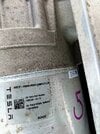I had thought along similar lines, diy method. However, thinking about the QC charge and tesla revision u manifolds, there would still be coolant flowing near to the end of the rotor tube. Wouldn't there be some cooling effect due to conduction through the motor end plate, hot air escaping the rotor tube near to the manifold and radiant heat from the reluctor wheel and nearby bearing?We looked over everything we can glean from pictures and it looks like doing the 'two plug' method should work fine. What are we missing?
Welcome to Tesla Motors Club
Discuss Tesla's Model S, Model 3, Model X, Model Y, Cybertruck, Roadster and More.
Register
Install the app
How to install the app on iOS
You can install our site as a web app on your iOS device by utilizing the Add to Home Screen feature in Safari. Please see this thread for more details on this.
Note: This feature may not be available in some browsers.
-
Want to remove ads? Register an account and login to see fewer ads, and become a Supporting Member to remove almost all ads.
You are using an out of date browser. It may not display this or other websites correctly.
You should upgrade or use an alternative browser.
You should upgrade or use an alternative browser.
brainhouston
Active Member
only thing comes to mind is possibly trapping all the hot coolant in the tube, it'll most likely heat up being inside hot rotor n since the top flow will be gone, it won't be flushed outWe looked over everything we can glean from pictures and it looks like doing the 'two plug' method should work fine. What are we missing?
i seriously doubt it adds any significant cooling that way...I had thought along similar lines, diy method. However, thinking about the QC charge and tesla revision u manifolds, there would still be coolant flowing near to the end of the rotor tube. Wouldn't there be some cooling effect due to conduction through the motor end plate, hot air escaping the rotor tube near to the manifold and radiant heat from the reluctor wheel and nearby bearing?
Howards idea with leaving the tube in will add much more surface cooling if there was a way to make coolant circulate out of it...
only thing comes to mind is possibly trapping all the hot coolant in the tube, it'll most likely heat up being inside hot rotor n since the top flow will be gone, it won't be flushed out
Intersting concern. I guess a more destructive cutting off most of manifold feed tube and cap the opening would be a solution.
A random non practical thought is forced air cooling rather than coolant through the existing hallow rotor shaft (need manifold channel mod + air seal + pump design etc). Would probably need quite a bit more flow rate to address air's lower heat removal capacity. Been researching too much on gas cooled nuclear power plants haha.
i seriously doubt it adds any significant cooling that way...
I would agree manifold whisking away rotor heat by just passing coolant through it (and not the rotor) is minimal. Manifold is RTVed onto the end plate. End plate is RTVed onto the stator casing so lots of insulators as well.
Last edited:
brainhouston
Active Member
Definitely can experiment, maybe even putting temp sensor in the tube
U can always start with less invasive bypass then go into cutting/drilling...
Would be fun experiment in my future
U can always start with less invasive bypass then go into cutting/drilling...
Would be fun experiment in my future
Definitely can experiment, maybe even putting temp sensor in the tube
U can always start with less invasive bypass then go into cutting/drilling...
Would be fun experiment in my future
For temp sensor, I think easiest is to put hole in end plate and point IR right at the end of the rotor. Can read after stopping or more advanced install for live reading. Ideally do it before any cooling mod for reference and after. If experienced with oil tipped slow drilling Al to avoid dumping shavings inside the hole, might even be able to do this with LDU in the car before any mod effort. Decisions decisions...
But I decided against collecting reference temp value since don't have any idea what time to failure curve based on temp looks like. Curious why all the induction or any EV motor design engineers never chime in on these EV forums. Maybe Tesla's social media marketing prowess has all the knowledgeable design engineers all bottled up. Heck the few LDU rebuild shops that is churning through probably 100+ of these daily are still invisible to us. haha.
brainhouston
Active Member
i was thinking of just stashing a wireless one in the tube like i did with humidity sensor in the HV pack.For temp sensor, I think easiest is to put hole in end plate and point IR right at the end of the rotor. Can read after stopping or more advanced install for live reading. Ideally do it before any cooling mod for reference and after. If experienced with oil tipped slow drilling Al to avoid dumping shavings inside the hole, might even be able to do this with LDU in the car before any mod effort. Decisions decisions...
But I decided against collecting reference temp value since don't have any idea what time to failure curve based on temp looks like. Curious why all the induction or any EV motor design engineers never chime in on these EV forums. Maybe Tesla's social media marketing prowess has all the knowledgeable design engineers all bottled up. Heck the few LDU rebuild shops that is churning through probably 100+ of these daily are still invisible to us. haha.
not sure if i'll get a signal out so might need to get one with sensor on pigtail n drill a hole
technically shouldn't even need to drill a hole if i can route the wire thru top hole for the jump line...
Engineers usually busy working or designing n i think TMC is like a DYI community so pretty low level for engineers to hang out here...
If that's the case, would there be any merit in reversing the coolant flow through the whole drive unit? Would doing that cause the rotor seal to leak more or leak less?I've seen some chatter on openinverter on split coolant loop (cool inverter and motor separately) People didn't like the fact that cooler running inverter gets cooled after the motor. Unfortunately can't find the thread atm.
My 2014 85s drive unit was changed in July 2019, under the previous owner. I believe it was new (see photo).I just checked my speed sensor for the second time. The first time i checked it at around 20,000 miles, it was greasy. This time, 50,000 miles, it was completely dry. So i hope I'll have time to consider the best solution.


Indirectly related to drive unit repair, I’m curious if your option code (or anyone with a recent DU replacement) now shows DU01 (or DU00 for small). I assume that Tesla will run out of non DU0x drive units and just stock the newer ones, but there is some chance the newer can’t be retrofit.My 2014 85s drive unit was changed in July 2019…
Maybe more relevant here, does anyone know if the cooling or seals in the large DU changed with that June 2017 revision? Might be just inverter electronics and nothing in the drive unit itself.
Where would i find that DU01 ? I assume you don't mean on stickerIndirectly related to drive unit repair, I’m curious if your option code (or anyone with a recent DU replacement) now shows DU01 (or DU00 for small). I assume that Tesla will run out of non DU0x drive units and just stock the newer ones, but there is some chance the newer can’t be retrofit.
Maybe more relevant here, does anyone know if the cooling or seals in the large DU changed with that June 2017 revision? Might be just inverter electronics and nothing in the drive unit itself.
It’s an option code. You used to be able to look at the HTML code when viewing your car’s page on the Tesla site from a desktop browser. Something like right click and “view source”. These might be better instructions.Where would i find that DU01 ? I assume you don't mean on sticker
If that's the case, would there be any merit in reversing the coolant flow through the whole drive unit? Would doing that cause the rotor seal to leak more or leak less?
I think no rotor cooling leak improvement reversing the flow. Any coolant in that area will leak if seal/shaft surface is not ideal.
Reverse flow likely also cause poor rotor cooling because
- rotor coolant channel split on the normally output side is on top of the heat exchanger. Likely a less efficient Y split if feed coolant in from outlet on bottom. If air pocket then even worse
- manifold rotor cooling channel has small tube U turn into big tube if feed from normal input path. Reverse = big tube U into small tube, likely less efficient.
- Y split on normal input side likely will feed rotor cooling channel and become opposing pressure for the reverse feed of rotor cooling passage. Don't know the relative pressure from each end but likely will reduce rotor cooling efficiency.
It’s an option code. You used to be able to look at the HTML code when viewing your car’s page on the Tesla site from a desktop browser. Something like right click and “view source”. These might be better instructions.


These are the closest i could find.
Attachments
Maybe more relevant here, does anyone know if the cooling or seals in the large DU changed with that June 2017 revision? Might be just inverter electronics and nothing in the drive unit itself.
I've collected info on few LDUs, inconclusive on when seal is changed and there seems to multiple version of the seal. Adding the complexity of Toyota and Mercedes using the LDU (slightly different mechanically with a parking pawl inside the gearbox) and may have old stock inventory and/or additional deltas in the manufacturing processes, really makes it quite complex to decode this versionitis.
- On cooling passages, no change until revU that I'm aware of.
- On seals, seems Tesla went to failure prone single lip really quick. My guess is once they started reman to deal with early clunk and non ceramic bearing problems, changed to single lip seal to use with the used rotor shaft without refinishing the shaft surface. Just a guess. Don't have Tesla's secret info. Could have also use too hard seal material in the past (make seal last longer, score the shaft faster) and cause to switch to single lip. Don't really know the secret database of changes.
- RevQ did eliminate the breather hole in speed sensor cavity trying to slow down the aerosolized coolant from leak agitated by the speed sensor wheel traveling to the stator/inverter.
Tesla LDU - Revisions
Many Revisions Tesla has had many version of the LDU and most cars were getting LDUs replaces every few 10k miles with regularity. My 2013 MS has had the original (don't know Rev) to Rev K and then onto Rev Q all in 40k miles. There are some differences between all these Revs. Following is not a
This does look like a new unit which is probably why it is dry at 50,000 miles. Mine is a original/new and was dry when I checked at about 70,000. I'm going to keep running it until it starts to leak. When that happens, hopefully we will have an extremely high instance of 'no problems' from the early coolant-delete adopters.My 2014 85s drive unit was changed in July 2019, under the previous owner. I believe it was new (see photo).I just checked my speed sensor for the second time. The first time i checked it at around 20,000 miles, it was greasy. This time, 50,000 miles, it was completely dry. So i hope I'll have time to consider the best solution. View attachment 1006787
First, I did not read the whole thread, but I am pasting here a link to a local EV repair garage that do wonders...
they claimed to have somehow "fixed" the leaking LDU:
Ps, not 100% fixed but it should last much longer than original Tesla's
they claimed to have somehow "fixed" the leaking LDU:
Ps, not 100% fixed but it should last much longer than original Tesla's
First, I did not read the whole thread, but I am pasting here a link to a local EV repair garage that do wonders...
they claimed to have somehow "fixed" the leaking LDU:
Ps, not 100% fixed but it should last much longer than original Tesla's
Seen EV Clinic's videos on LDU repair. They do really good process to recondition the rotor shaft (looks like they chrome plate -> polish) Tesla reman doesn't seem to recondition the shaft surface based on inspecting my reman LDU.
PTFE seal and shaft surface are both key factors in a good seal. If shaft surface is worn, seal won't work. Furthermore, PTFE seal has many different harness depending on material blends. Embedding harder particles in the seal will make it last longer. However, harder seal will also wear the shaft faster so compromise must be found.
I guess this is part of the reason Tesla went to single lip seal very quickly. Maybe they started out with too hard triple lip PTFE which then slightly damaged the shaft surface? Also Tesla remanufacturing effort doesn't seem to recondition the shaft surface and the surface seems to have very thin layer of anti-corrosion coating. Using triple lip seal on a compromised anti-corrosion shaft surface will cause rust (happen to me). So this is my guess on why Tesla went to single lip seal so early on. They should have done proper rotor shaft reconditioning like EV Clinic.
Anyway, EV Clinic is doing the proper rebuild process. But it isn't so easy to find rebuilder that can chrome plate, polish, and rebuild a drive unit at least here in US. Usually chrome plate shops don't do precision work in US... just classic car bumper etc. I heard from an EU member chrome plating rotor shaft is also not easy. First have to machine off thin layer of material, then do multiple plating passes to get a plating that bonds.
C/P from evclinic:
Our new coolant system cant ever ever again let coolant inside stator.
Our new stator cant ever ever get low isolation or overheating problems
Our new stator should increase range and power, decrease heating of the system
Our complete LDU assembly should last at least 700000km
If this is true, then its really good news. I want a P100D model, but untill now the fear of replacing LDU every xy K miles was a deal braker...
Do you think its true what the evclinic is saying and that even the LDU can be "fixed" properly?
Our new coolant system cant ever ever again let coolant inside stator.
Our new stator cant ever ever get low isolation or overheating problems
Our new stator should increase range and power, decrease heating of the system
Our complete LDU assembly should last at least 700000km
If this is true, then its really good news. I want a P100D model, but untill now the fear of replacing LDU every xy K miles was a deal braker...
Do you think its true what the evclinic is saying and that even the LDU can be "fixed" properly?
@howardc64 how is your LDU doing after your re-sealing?
My first reseal with triple lip seal + polished shaft resulted in rust under the lip interior chambers ( link ) then try to do flame spray to repair the shaft like carrepairvideo on youtube but terrible result (porous finish link and ruined chamfer link )
Finally tried SKF speedi sleeve with SKF FKM seal. FKM can't handle this high surface speed application but one guy said good result on LDU for 15k+ miles. Unfortunately, mine leaked in 1k miles as expected since FKM material can't handle this application's surface speed.
This is where I am now. I have a made in Germany well engineered ( precisely cut, garter spring for precise lip pressure ) single lip PTFE seal @muehlpower on openinverter.org developed for this LDU ( link ). Much better than Tesla's style cheaper manufactured curled lip shape to apply sealing pressure single lip seal. Now debating to install this seal or do coolant delete.
Similar threads
- Replies
- 19
- Views
- 8K
- Replies
- 55
- Views
- 19K



